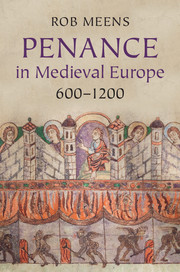Book contents
- Frontmatter
- Dedication
- Contents
- List of Figures
- Acknowledgments
- 1 Introduction
- 2 The late antique legacy
- 3 A new beginning? Penitential practice in the insular world
- 4 Insular texts on the move: penance in Francia and England
- 5 Penance and the Carolingian Reforms
- 6 New penitential territories: the tenth and eleventh centuries
- 7 The twelfth century
- Conclusion
- Appendix 1 The manuscripts of Theodore’s penitential
- Appendix 2 The manuscripts of the Excarpsus Cummeani
- Appendix 3 The manuscripts of the Bede and Egbert penitentials
- Appendix 4 The manuscripts of Halitgar’s penitential
- Sources
- Bibliography
- General index
- Manuscript index
- References
3 - A new beginning? Penitential practice in the insular world
Published online by Cambridge University Press: 05 August 2014
- Frontmatter
- Dedication
- Contents
- List of Figures
- Acknowledgments
- 1 Introduction
- 2 The late antique legacy
- 3 A new beginning? Penitential practice in the insular world
- 4 Insular texts on the move: penance in Francia and England
- 5 Penance and the Carolingian Reforms
- 6 New penitential territories: the tenth and eleventh centuries
- 7 The twelfth century
- Conclusion
- Appendix 1 The manuscripts of Theodore’s penitential
- Appendix 2 The manuscripts of the Excarpsus Cummeani
- Appendix 3 The manuscripts of the Bede and Egbert penitentials
- Appendix 4 The manuscripts of Halitgar’s penitential
- Sources
- Bibliography
- General index
- Manuscript index
- References
Summary
For over a hundred years historians have taken for granted that private penance originated in Ireland. Since Paul Fournier demonstrated that those penitential handbooks which Hermann Joseph Schmitz still believed to be of Roman origin were actually written in Francia on the basis of earlier texts composed in Ireland and England, it has been generally assumed that penitential handbooks as we know them from the early Middle Ages originated in Ireland and the regions dominated by Celtic-speaking peoples in Britain. There is no doubt that the earliest texts of this new genre do indeed stem from these regions. However, this does not automatically imply that private penance originated with these texts, as so many authors have assumed. As this chapter will demonstrate, there are many uncertainties about the status and the function of penitential handbooks in early medieval Ireland and Wales and their role may at the same time have been more constricted than historians have assumed, but also more far-reaching.
First we have to remember that Christianity had taken root in Ireland at some point in the fifth century. The chronicler Prosper of Aquitaine recorded that in the year 431 a deacon by the name of Palladius had been sent to ‘the Irish who believe in Christ’ as their first bishop, by Pope Celestine I. As Pope Leo I, with whom Prosper was in close contact, recognized, the introduction of Christianity into Ireland was a unique event, since it meant that Christianity transcended the political boundaries of the Roman empire. Whereas in Gaul the position of the bishop could in many aspects relate to the Roman past, this was much harder in Ireland where, for example, no towns existed which were comparable to the late Roman towns as they were found in regions of the former Roman empire. The earliest phases of the process of Christianization in Ireland still raise many questions. The relationship between Palladius and Patrick, for example, is a perennial question in early Irish history. Palladius was a deacon of the church of Auxerre prior to his departure for Ireland and was closely connected to the influential bishop of Auxerre, Germanus, who combatted Pelagianism in Britain.
- Type
- Chapter
- Information
- Penance in Medieval Europe, 600–1200 , pp. 37 - 69Publisher: Cambridge University PressPrint publication year: 2014



